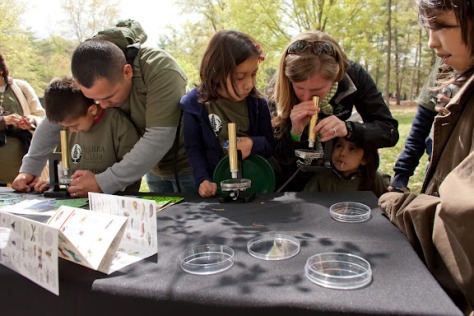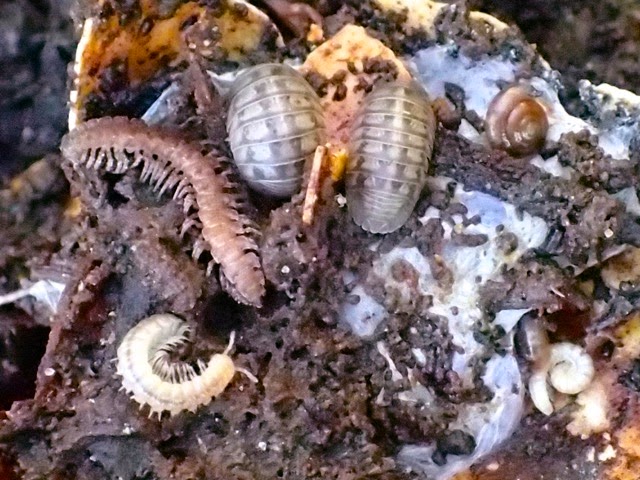On Valentine's Day I went to the Virginia Association of Science Teacher's conference on Inspiring a Love of Science with STEA*M (Science, Technology, Engineering, *the Arts and Mathematics). Keynote Speaker Margaret Hancock presented on "Thinking like Artists and Designers". Her photos of the iconic Saarinen Womb chair and the Glasshouse by Mies Van der Rohe, reminded me of my architecture school days of thirty years ago! Then Margaret updated us to our digital ecologically-aware age with images from Patrick Dougherty's Stickwork and the architecture of Rural Studio.
Why S.T.E.A.M?
Observing and understanding nature is what Science is theoretically, but how and why? I never bought that "only observer" deal anyway. Did you? So the moment you acknowledge your active participation in systems: here comes integrating Engineering while gathering, hunting for and inventing the tools, the Technology, to help the observation, inquiry and the inevitable impetus to design and the iterative process. And whether you name it or not, you will add the Arts (and no doubt some aspects of religion or faith) to help with decision-making between various solutions and to acknowledge our basic need for symbolic references. Underlying patterns, economics and relations between all the variables there is a lot of Math, even if it is beyond your and my ability to solve for "x". So we have integrated STEAM in a nutshell. STEAM is more than just the sum of the parts:it shows emergence and synergy.
Talking of metaphors: I thought about calling this blog "Green STEAM Learning". But "Green STEAM" conjured up images of wilted lettuce and viridian clouds, so I went with the simpler "Green STEM Learning" to convey themes of integrated environmental education and sustainability.
STEAM at Home
Here is a simple example of "thinking like an artist and designer" and the synergy of STEAM in action at home.
My daughter and I spent some afternoons setting ourselves the task of making some jewelry together. We decided to go with a "cheap eats" theme and to collaborate. She decided to make Junk Food Jewelry while I made some Wearable Edible veggi brooches. And yes, we assessed plenty of social values and prejudices right there.
 |
| Junk Food Jewelry |
We bought premixed polymer clay. And weighed the pros and cons and viability of alternatives such as homemade salt dough. Polymer clays are expensive, hence our decision to make small things. The color range can be enhanced by combining clays and adding pastel dust with a paintbrush. And you might experiment with some shaping tools in addition to fingers. Then you bake the objects in the oven for a few minutes to set.
 |
| Wearable Edibles |
The engineering comes into play with questions such as:
- How to create objects that work on necklaces, brooches, bracelets?
- Do they balance well when you wear them?
- Do they move successfully with the body, or fall off?
- What kind of glue or fitting works best to fix a clay shape onto a metal armature?
It is a challenge to work within the budget, timeframe, technical capability and health and safety protocols that we have here at home - or you might have in the classroom.
The creative and engineering processes are all about "having a go", experiments, analysis, feedback and iterative design. For example: the first peapod brooch toppled over on wearing. So I drew a cross-section and decided to hollow out the back and recess the brooch clip. This technique works well on the carrot and leek brooches too.
The peapods were easier to make if individual peas were baked first to harden, then clad with the pod layers and rebaked. The radish soft magenta color was achieved with pastel and water coloring - a more subtle shade than achieved by clay alone. We also used 3D modeling to good effect on the radish and chocolate chip cookies. The carrot and fronds were based on form of the pink cancer awareness ribbon brooch.
My daughter's Junk Food Jewelry and my Wearable Edibles selections both work on the symbolic artistic level, referencing well-known foods and vegetables at a miniature scale.
The result our collaborative, FUN, STEAM project-based learning.
We decided the plain chocolate chip pendant and earrings are a hit, and would sell like "hot cakes" with teens and other audiences.
Now two years on, my daughter still enjoys making and experimenting with polymer clay. Her latest line is in "chibi" portraits as gifts to her classmates.
 |
| Emma's Chibi |
 |
| Michelle's Chibi |
She also takes classes at the community center to learn to throw pots, and she has chosen to study Ceramics at High School.
STEAM at Work
At this weekend's Love of Science and STEAM conference I went to other inspirational sessions. I heard George Mason Professor, Changwoo Ahn talk about his collaborative work:EcoScience + Art and current initiative: "The Rain Project - sustainable water management in an era of climate change" and his proposal for future efforts on food systems, soil and composting "The Dirt Project".
I enjoyed meeting Andrea Brothers from Micron Technology, and her multi-faceted presentation on life choices and career paths. She practices electron-microscopy to enhance yields of silicon memory products, plays violin and blends interests in art, science and technology. She played us her latest tunes, and shared her passion for innovation and design.
 |
| Andrea Brothers |
STEAM at Play
I trained for many years as an architect. I also think like an architect unschooled. Here's one of my "early play dwellings", a Mouse House, or perhaps it is a model for a silicon chip?
 |
| On the Beach, Chios, April 1971 |
Here's to an integrated approach to education, creativity, experimenting and innovation, and to enabling holistic choices and designs. Whether or not you call it STEAM.
Thanks to Susan Bardenhagen for hosting VAST Region 8 PD Conferences, and being the VAST Region 8 Representative, and thank you to my daughter Maya, Andrea Brothers, Changwoo Ahn and Margaret Hancock for sharing their love and inspirations.











